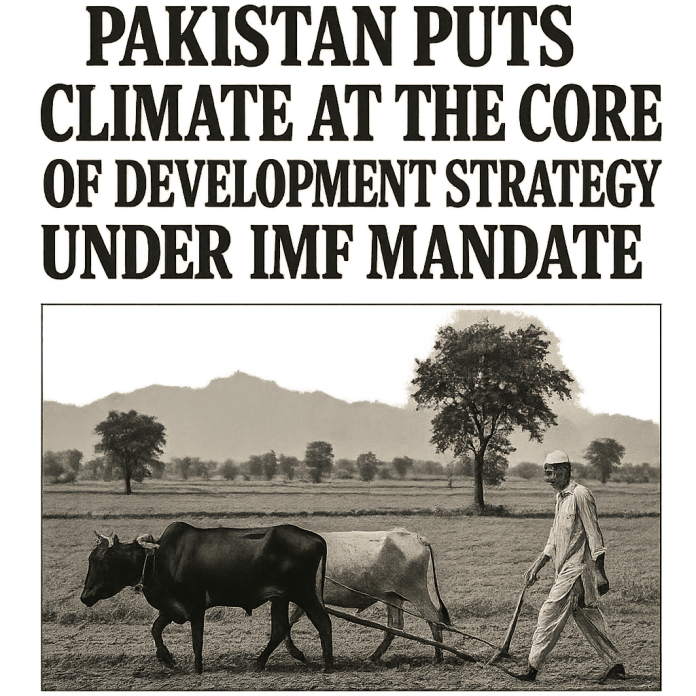By Ashrafuddin Pirzada
PESHAWAR: As Pakistan edges toward climate-focused development under the watchful eye of the International Monetary Fund (IMF), the country finds itself at a critical juncture. With rising temperatures, erratic rainfall, glacial melting, and crippling floods, Pakistan’s vulnerability to climate change is no longer a distant threat—it’s a daily reality.
From the sandy stretches of Tharparkar to the snow-capped peaks of Gilgit-Baltistan, communities across the nation have faced nature’s wrath. The devastating floods of 2022, which submerged a third of the country, displaced millions and caused economic damages worth over $30 billion, served as a rude awakening for policymakers. Since then, climate discourse has gradually shifted from the periphery to the center of national planning.
In response to this existential challenge, the government has committed to prioritizing climate-friendly projects in its Public Sector Development Programme (PSDP). A landmark decision in this regard was the agreement with the IMF to allocate at least 30 percent weight to climate considerations in infrastructure project selection by August 2026.
This change, however, is not just about meeting donor conditions. “Climate change is a development issue now,” said a senior official from the Planning Commission. “Every rupee we spend without considering environmental impact is a rupee spent on future disasters.”
The government’s pledge to publish project evaluation scores and undertake climate screening assessments represents a move toward transparency and accountability. It also reflects a growing awareness that unchecked infrastructure development, without environmental safeguards, can do more harm than good.
Environmentalists and civil society actors have long demanded such measures.
“We have seen highways built through wetlands, dams planned without community consultation and deforestation in the name of development,” said Shumaila Bano, a climate activist based in Swat.
“This new focus is welcome, but it must be backed by action on the ground.”
Pakistan’s ecological hotspots are under severe stress. The Indus River system, which sustains millions, is shrinking due to declining snow cover and rising temperatures. The country’s per capita water availability has dropped from 5,600 cubic meters in 1951 to less than 1,000 cubic meters today, below the scarcity threshold.
Similarly, urban centers like Lahore and Karachi grapple with toxic air pollution. In winter, Lahore often ranks among the most polluted cities globally, with hazardous smog blanketing schools, homes and hospitals. Despite court orders and public outcry, enforcement against polluters remains weak.
The agricultural sector, the backbone of Pakistan’s economy, is also bearing the brunt. Erratic weather patterns, droughts and soil degradation are reducing yields and threatening food security. Farmers are struggling to cope, lacking access to climate-resilient seeds, crop insurance, and water-efficient irrigation.
In response, adaptation and mitigation efforts are being slowly rolled out. Pakistan’s National Adaptation Plan and updated Nationally Determined Contributions (NDCS) under the Paris Agreement outline goals for renewable energy, forest restoration and sustainable water management. Yet, critics argue that implementation remains patchy and underfunded.
The new requirement for all major infrastructure projects to undergo climate vulnerability assessments by 2027 could help reverse this trend. If enforced sincerely, this could steer investments toward flood protection, renewable energy, green transport and climate-smart agriculture.
However, challenges remain. Provinces have varying capacities to carry out climate assessments.
“We need trained human resources, clear guidelines and independent oversight,” said Dr. Ahmed Nawaz, a development economist. “Otherwise, these reforms may become another paper exercise.”
As Pakistan retools its development priorities under fiscal pressure and ecological duress, its choices will have long-term implications. The road to climate resilience is complex, requiring political will, public awareness and cross-sector collaboration.
For now, the shift toward climate-conscious development planning offers a glimmer of hope. If followed through with seriousness, it could help Pakistan move from climate victim to climate leader in the region. The question is whether this moment will spark sustained change or be lost in the bureaucracy of promises and plans.











